Baldwin "DR-6-4-2000" Locomotives: Specs, Roster, Data Sheet
Last revised: December 28, 2024
By: Adam Burns
There were several variations of the DR-6-4-2000 during its
construction run from the mid-1940s through the late 1940s.
In total, there were not many actual locomotives built although the design featured a wide range of carbodies including the "Baby Face" (Gulf, Mobile & Ohio, "Sharknose" (Pennsylvania), and "Dual Cab" (Central Railroad Of New Jersey).
The DR-6-4-2000 would be the very last passenger cab unit Baldwin offered.
The company was never very successful in that particular market although, as John Kirkland points out in his book, "The Diesel Builders: Volume Three (Baldwin Locomotive Works," it focused primarily on special orders for these locomotives.
In the freight arena, Baldwin had much more success, particularly with the later RF16 "Sharknose" variant.
The DR-6-4-2000 primarily resembled models being offered by EMD with comparable horsepower, length, and an A1A-A1A truck design.
The company continued to lack standardization until a new diesel line appeared in the early 1950's. Today, there are no DR-6-4-2000s preserved.
Photos
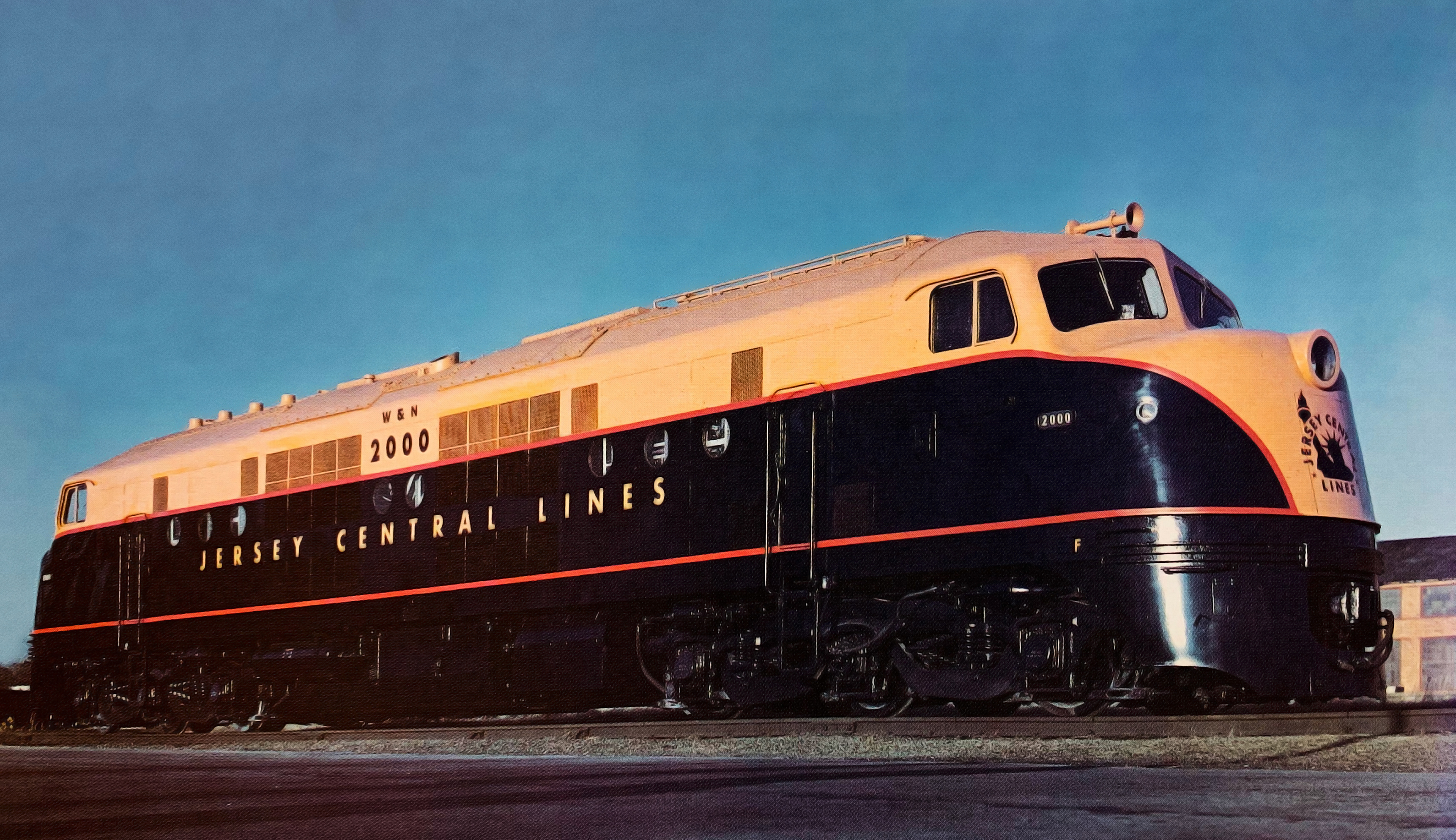 A Baldwin builder's photo featuring Jersey Central 0-6-6-0 1000/2 #2000 (sub-lettered for subsidiary Wharton & Northern) on November 19, 1946. These units, reclassified as the DRX-6-4-2000 following the completion of #2003, were acquired by the CNJ for commuter service. The double-ended design was to eliminate turning the locomotives at the Hudson River waterfront in Jersey City, New Jersey (Communipaw Terminal).
A Baldwin builder's photo featuring Jersey Central 0-6-6-0 1000/2 #2000 (sub-lettered for subsidiary Wharton & Northern) on November 19, 1946. These units, reclassified as the DRX-6-4-2000 following the completion of #2003, were acquired by the CNJ for commuter service. The double-ended design was to eliminate turning the locomotives at the Hudson River waterfront in Jersey City, New Jersey (Communipaw Terminal).Overview
The original version of the DR-6-4-2000 can be traced back to January 10, 1945 when Baldwin unveiled its first passenger model demonstrator, #2000. It was later joined on March 28th of that year by a second demonstrator, #2001.
These locomotives, listed as Class 0-6-6-0 1000/2 DE1 and DE2, featured a pair of 1,000 horsepower model 8VO diesel engines for a total of 2,000 horsepower each (construction numbers 70320 and 70321).
They utilized an A1A-A1A truck setup (center axle unpowered) and featured Baldwin's ubiquitous "Baby Face" carbody design.
The locomotives featured 21:58 gearing, which enabled a continuous tractive effort of 28,500 pounds at 21.5 mph.
They toured extensively across the Northeast and Midwest before being sold to the National Railways of Mexico where their gearing was changed to 15:63 (and continuous tractive effort bumped up to 42,800 pounds at 14.3 mph).
The DR-6-4-2000 featured an upgraded prime mover (608NA) and a wide range of gearing available (featured in the table below).
The most unique variant were five double-ended design built for Central Railroad of New Jersey subsidiary Wharton & Northern. These were classed as the 0-6-6-0 1000/2 (early version) and later DRX-6-4-2000.
Externally the locomotives were the same length as the single-cab variants. In addition, they featured the same internal components.
The CNJ acquired the units primarily for commuter service and to eliminate turning the locomotives at its Hudson River waterfront in Jersey City, New Jersey (Communipaw Terminal).
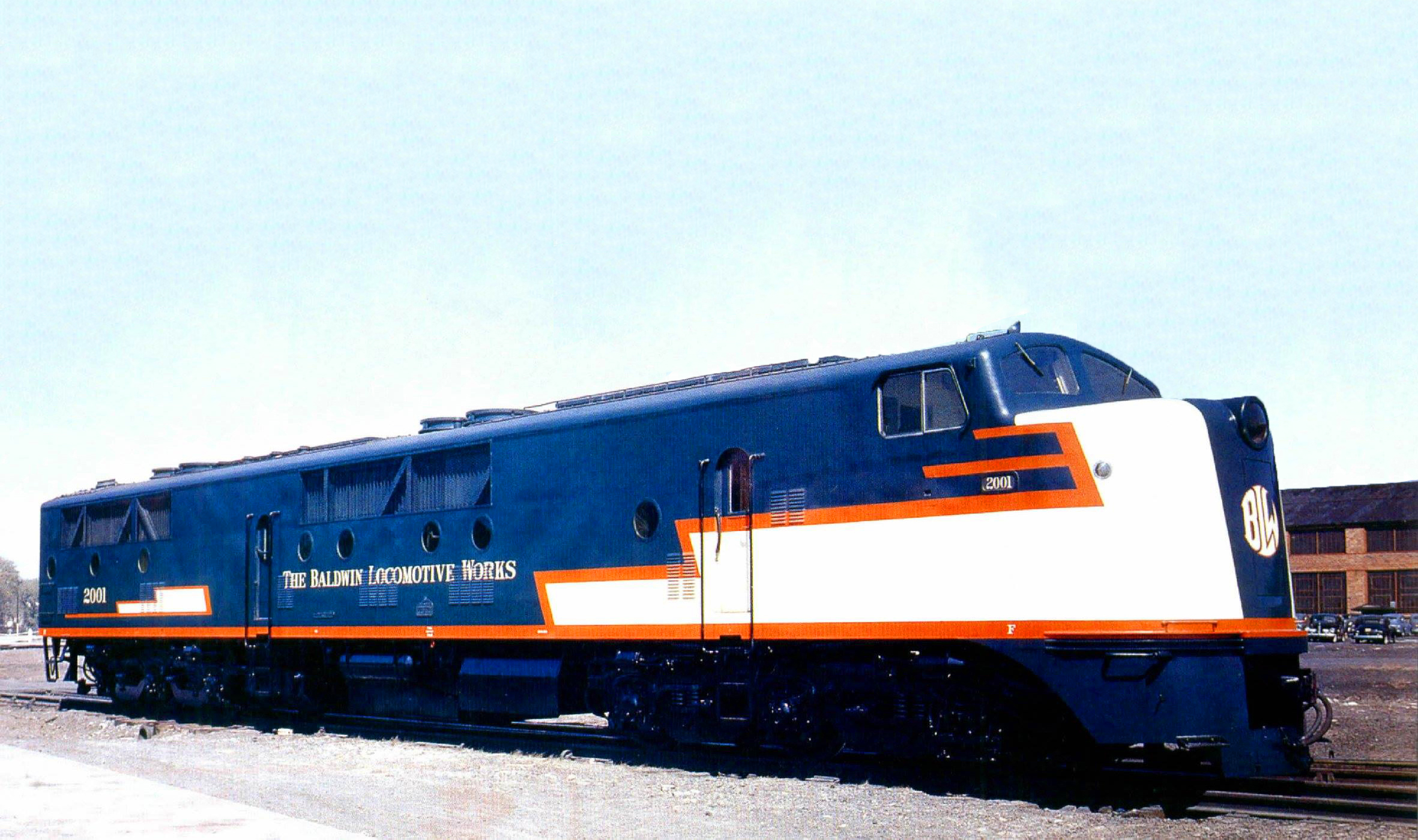 A Baldwin company photo showcasing one of its two demonstrator DR-6-4-2000's, #2001, in late March of 1945, which utilized the 608NA 8-cylinder, naturally aspirated engine. This unit, and sister #2000, were eventually acquired by Mexico's Ferrocarriles Nacionales de México (NdeM).
A Baldwin company photo showcasing one of its two demonstrator DR-6-4-2000's, #2001, in late March of 1945, which utilized the 608NA 8-cylinder, naturally aspirated engine. This unit, and sister #2000, were eventually acquired by Mexico's Ferrocarriles Nacionales de México (NdeM).The final "Baby Face" version of the DR-6-4-2000 also featured the 606NA prime mover and only a few were built in the second half of 1948:
- Two for the Gulf, Mobile & Ohio
- Three for Ferrocarriles Nacionales de México (two of which were original demonstrators)
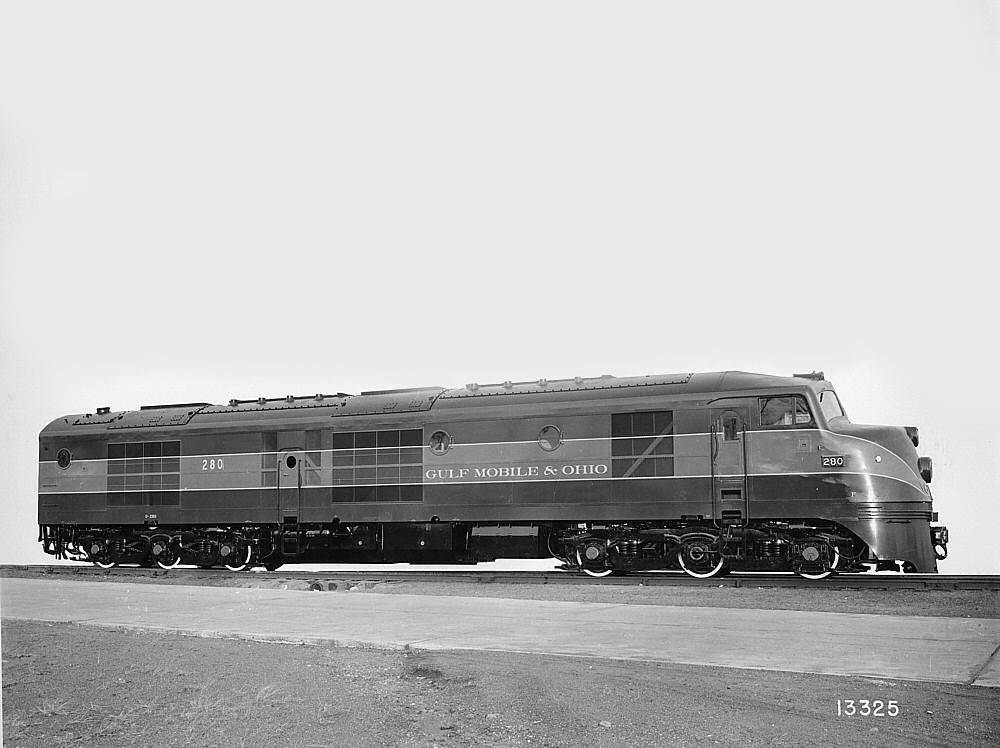 A Baldwin company photo of brand new Gulf, Mobile & Ohio DR-6-4-2000 #280 taken in 1947, wearing the earlier "Baby Face" carbody. The GM&O owned just two of these locomotives, #280-281.
A Baldwin company photo of brand new Gulf, Mobile & Ohio DR-6-4-2000 #280 taken in 1947, wearing the earlier "Baby Face" carbody. The GM&O owned just two of these locomotives, #280-281.The absolute final version of the Baldwin DR-6-4-2000 was shrouded in the famous "Sharknose" carbody. Its only difference from the previous version was that it featured Baldwin's latest 606SC prime mover.
This final version was built for Baldwin's unwavering supporter, the Pennsylvania Railroad, which purchased 18 'A' units and 9 'B' units.
Internal components for all of the DR-6-4-2000 variants were outsourced to Westinghouse Electric.
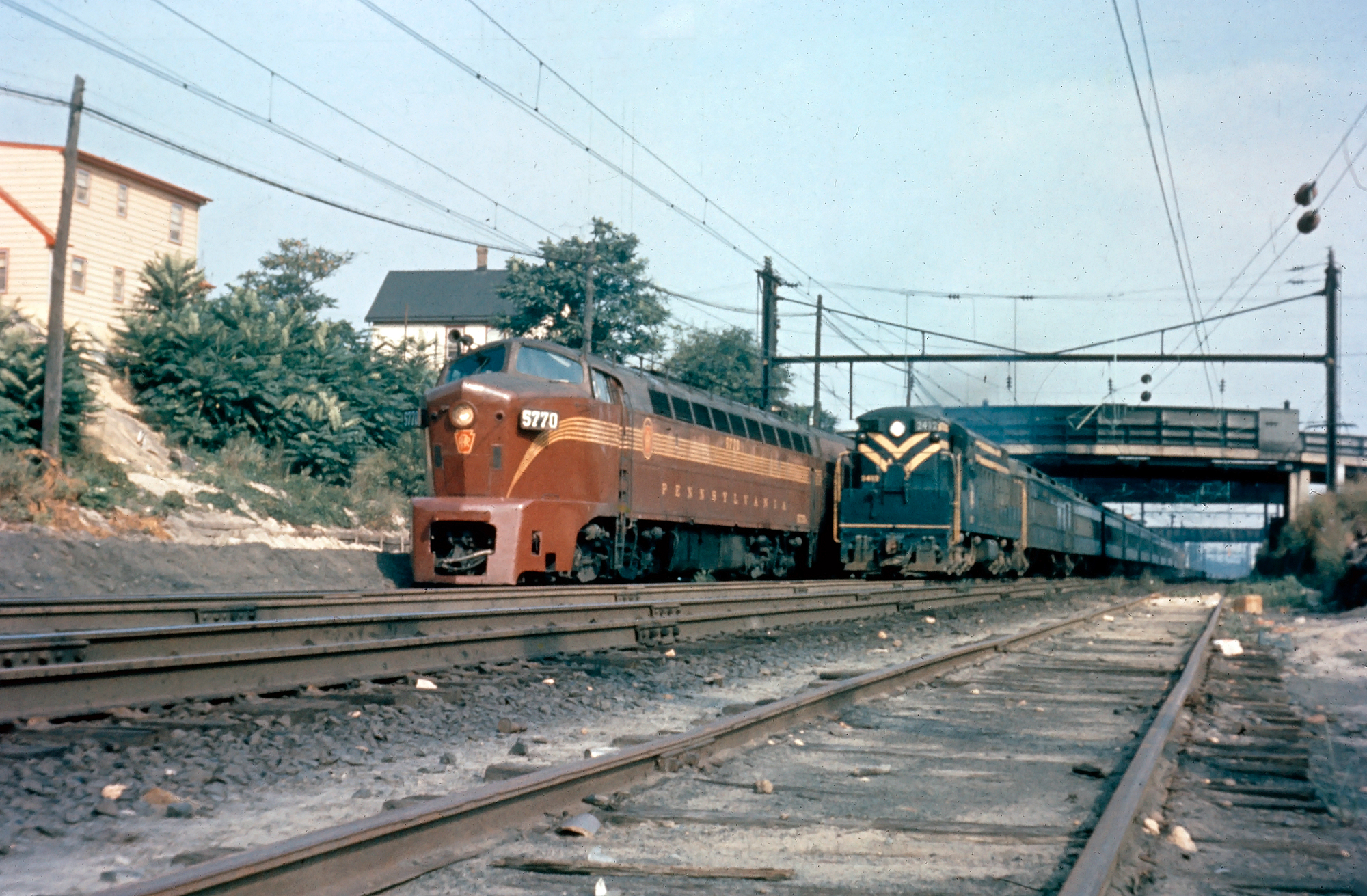 Pennsylvania DR-6-4-2000 #5770 and Jersey Central "Train Master" #2412 work suburban service on the New York & Long Branch at South Amboy, New Jersey, circa 1958. Meyer Pearlman photo. American-Rails.com collection.
Pennsylvania DR-6-4-2000 #5770 and Jersey Central "Train Master" #2412 work suburban service on the New York & Long Branch at South Amboy, New Jersey, circa 1958. Meyer Pearlman photo. American-Rails.com collection.The classification system Baldwin used for its early diesel designs was a mess to try and decode but once it is explained is fairly simple to understand.
The system is based from the Whyte Notation that classified steam locomotives. As an example using the DR-6-4-2000:
- "DR" referred to Diesel Road unit
- The first 6 regarded six total axles
- The second number, 4, was the designation of four powered traction motors
- 2,000 was the horsepower rating
Many times the classification would be shortened for simplicity such as DR-6-4-20.
Total Built (All Variants): 30
Gearing Options
| Gear Ratio | Maximum Speed | Continuous Tractive Effort (Lbs) | Continuous TE Rating Speed |
|---|---|---|---|
| 15:63 | 65 | 42,800 | 14.5 |
| 19:60 | 82 | 32,200 | 19.5 |
| 21:58 | 93.5 | 28,100 | 22.0 |
| 22:57 | 100 | 26,300 | 23.5 |
| 23:56 | 106 | 24,800 | 25.0 |
| 25:54 | 120 | 22,000 | 28.5 |
Data Sheets and Specifications
0-6-6-0 1000/2 (Double-Ended)
Data Sheet
| Entered Production | 11/19/1946 (Central Railroad Of New Jersey #2000) |
| Years Produced | 11/19/1946 - 2/14/1947 |
| Baldwin Class | 0-6-6-0 1000/2 |
| Engine | 608NA |
| Engine Builder | De La Vergne |
| Horsepower | 2000 |
| Carbody Styling | Baldwin |
| Length (Between Coupler Pulling Faces) | 80' |
| Weight | 375,000 Lbs |
| Trucks | A1A-A1A |
| Truck Type | GSC Swing Bolster, Drop Side Equalizers |
| Truck Wheelbase | 15' 6" |
| Wheel Size | 40" |
| Traction Motors | 370F (4), Westinghouse |
| Traction Generator | 480D, Westinghouse |
| Auxiliary Generator | YG40E, Westinghouse |
| Gear Ratio | 21:58 |
| Tractive Effort Rating | 28,100 Lbs at 22.0 MPH |
| Top Speed | 93.5 MPH |
Production Roster (Double-Ended)
| Owner | Road Number | Baldwin Serial Number | Construction Number | Completion Date |
|---|---|---|---|---|
| Central Railroad Of New Jersey | 2000 | NA6 | 73060 | 11/19/1946 |
| Central Railroad Of New Jersey | 2001 | NA7 | 73061 | 12/9/1946 |
| Central Railroad Of New Jersey | 2002 | NA8 | 73062 | 2/14/1947 |
Production Roster (Single Cab)
| Owner | Road Number | Baldwin Serial Number | Construction Number | Completion Date |
|---|---|---|---|---|
| Baldwin Locomotive Works | 2000 (1st)* | DE1 | 73020 | 1/10/1945 |
| Baldwin Locomotive Works | 2001 | DE2 | 73021 | 3/28/1945 |
| Elgin, Joliet & Eastern | 100 | NA5 | 72831 | 5/13/1946 |
| National Railways Of Mexico | 6002 | DE9 | 72671 | 8/30/1946 |
Lots DE3 and DE4 were left vacant.
* Sold to National Railways of Mexico as #6000.
** Sold to National Railways of Mexico as #6001.
DR-6-4-2000 "Baby Face"
Data Sheet
| Entered Production | 1/4/1947 (Gulf, Mobile & Ohio #280) |
| Years Produced | 1/4/1947 - 2/12/1947 |
| Baldwin Class | 0-6-6-0 1000/2 |
| Engine | 608NA |
| Engine Builder | De La Vergne |
| Horsepower | 2000 |
| Carbody Styling | Baldwin |
| Length (Between Coupler Pulling Faces) | 80' |
| Weight | 375,000 Lbs |
| Trucks | A1A-A1A |
| Truck Type | GSC Swing Bolster, Drop Side Equalizers |
| Truck Wheelbase | 15' 6" |
| Wheel Size | 40" |
| Traction Motors | 370F (4), Westinghouse |
| Traction Generator | 480D, Westinghouse |
| Auxiliary Generator | YG40D, Westinghouse |
| Gear Ratio | 21:58 |
| Tractive Effort Rating | 28,100 Lbs at 22.0 MPH |
| Top Speed | 93.5 MPH |
Production Roster
| Owner | Road Number | Baldwin Serial Number | Construction Number | Completion Date |
|---|---|---|---|---|
| Gulf, Mobile & Ohio | 280 | 1 | 71580 | 1/4/1947 |
| Gulf, Mobile & Ohio | 281 | 1 | 71581 | 2/12/1947 |
DRX-6-4-2000 (CNJ)
Data Sheet
| Entered Production | 8/6/1948 (Central Railroad Of New Jersey #2003) |
| Years Produced | 8/6/1948 - 9/16/1948 |
| Baldwin Class | DRX-6-4-1000/2 |
| Engine | 608NA |
| Engine Builder | De La Vergne |
| Horsepower | 2000 |
| Carbody Styling | Baldwin |
| Length (Between Coupler Pulling Faces) | 80' |
| Weight | 375,000 Lbs |
| Trucks | A1A-A1A |
| Truck Type | GSC Swing Bolster, Drop Side Equalizers |
| Truck Wheelbase | 15' 6" |
| Wheel Size | 42" |
| Traction Motors | 370F (4), Westinghouse |
| Traction Generator | 480F, Westinghouse |
| Auxiliary Generator | YG42A, Westinghouse |
| Gear Ratio | 15:63 |
| Tractive Effort Rating | 42,800 Lbs at 14.5 MPH |
| Top Speed | 65 MPH |
Production Roster
| Owner | Road Number | Baldwin Serial Number | Construction Number | Completion Date |
|---|---|---|---|---|
| Central Railroad of New Jersey | 2003 | 1 | 73750 | 8/6/1948 |
| Central Railroad of New Jersey | 2004 | 2 | 73751 | 9/5/1948 |
| Central Railroad of New Jersey | 2005 | 3 | 73752 | 9/16/1948 |
The DRX-6-4-2000 double-ended design differed only from its earlier variant (0-6-6-0 1000/2) in that the control voltage was reduced from 125 volts to 75 volts, which conformed with AAR (Association Of American Railroads) standards.
This change subsequently resulted in main and auxiliary generators needing changed as well. The new variant also included 42 inch wheels to reduce slippage.
DR-6-4-2000 "Shark Nose"
Data Sheet
| Entered Production | 6/17/1948 (Pennsylvania #5770A-5771A [As] and #5770B [B]) |
| Years Produced | 6/17/1948 - 12/15/1948 |
| Baldwin Class | DR-6-4-1000/2 |
| Engine | 606SC |
| Engine Builder | De La Vergne |
| Horsepower | 2000 |
| Carbody Styling | Baldwin |
| Length (Between Coupler Pulling Faces) | 80' |
| Weight | 375,000 Lbs |
| Trucks | A1A-A1A |
| Truck Type | GSC Swing Bolster, Drop Side Equalizers |
| Truck Wheelbase | 15' 6" |
| Wheel Size | 42" |
| Traction Motors | 370F (4), Westinghouse |
| Traction Generator | 471A, Westinghouse |
| Auxiliary Generator | YG42A, Westinghouse |
| Gear Ratio | 22:57 |
| Tractive Effort Rating | 26,300 Lbs at 23.5 MPH |
| Top Speed | 100 MPH |
Production Roster
| Owner | Road Number | Baldwin Serial Number (A Unit) | Baldwin Serial Number (B Unit) | Construction Number | Completion Date |
|---|---|---|---|---|---|
| Pennsylvania | 5770 | 1 | 73505 | 6/17/1948 | |
| Pennsylvania | 5770B | 1 | 73523 | 6/17/1948 | |
| Pennsylvania | 5771 | 2 | 73506 | 6/17/1948 | |
| Pennsylvania | 5772 | 3 | 73507 | 8/28/1948 | |
| Pennsylvania | 5772B | 2 | 73524 | 8/28/1948 | |
| Pennsylvania | 5773 | 4 | 73508 | 8/28/1948 | |
| Pennsylvania | 5774 | 5 | 73509 | 9/24/1948 | |
| Pennsylvania | 5774B | 3 | 73525 | 9/24/1948 | |
| Pennsylvania | 5775 | 6 | 73510 | 9/24/1948 | |
| Pennsylvania | 5776 | 7 | 73511 | 10/20/1948 | |
| Pennsylvania | 5776B | 4 | 73526 | 10/20/1948 | |
| Pennsylvania | 5777 | 8 | 73512 | 10/20/1948 | |
| Pennsylvania | 5778 | 9 | 73513 | 10/28/1948 | |
| Pennsylvania | 5778B | 5 | 73527 | 10/28/1948 | |
| Pennsylvania | 5779 | 10 | 73514 | 10/28/1948 | |
| Pennsylvania | 5780 | 11 | 73515 | 10/30/1948 | |
| Pennsylvania | 5780B | 6 | 73528 | 10/30/1948 | |
| Pennsylvania | 5781 | 12 | 73516 | 10/30/1948 | |
| Pennsylvania | 5782 | 13 | 73517 | 11/17/1948 | |
| Pennsylvania | 5782B | 7 | 73529 | 11/17/1948 | |
| Pennsylvania | 5783 | 14 | 73518 | 11/17/1948 | |
| Pennsylvania | 5784 | 15 | 73519 | 11/26/1948 | |
| Pennsylvania | 5784B | 8 | 73530 | 11/26/1948 | |
| Pennsylvania | 5785 | 16 | 73520 | 11/26/1948 | |
| Pennsylvania | 5786 | 17 | 73521 | 12/15/1948 | |
| Pennsylvania | 5786B | 9 | 73531 | 12/15/1948 | |
| Pennsylvania | 5787 | 18 | 73521 | 12/15/1948 |
Sources
- Kirkland, John F. Diesel Builders, The: Volume Three, Baldwin Locomotive Works. Pasadena: Interurban Press, 1994.
- Pinkepank, Jerry A. Diesel Spotter's Guide. Milwaukee: Kalmbach Publishing Company, 1967.
- Solomon, Brian. Baldwin Locomotives. Minneapolis: Voyageur Press, 2009.
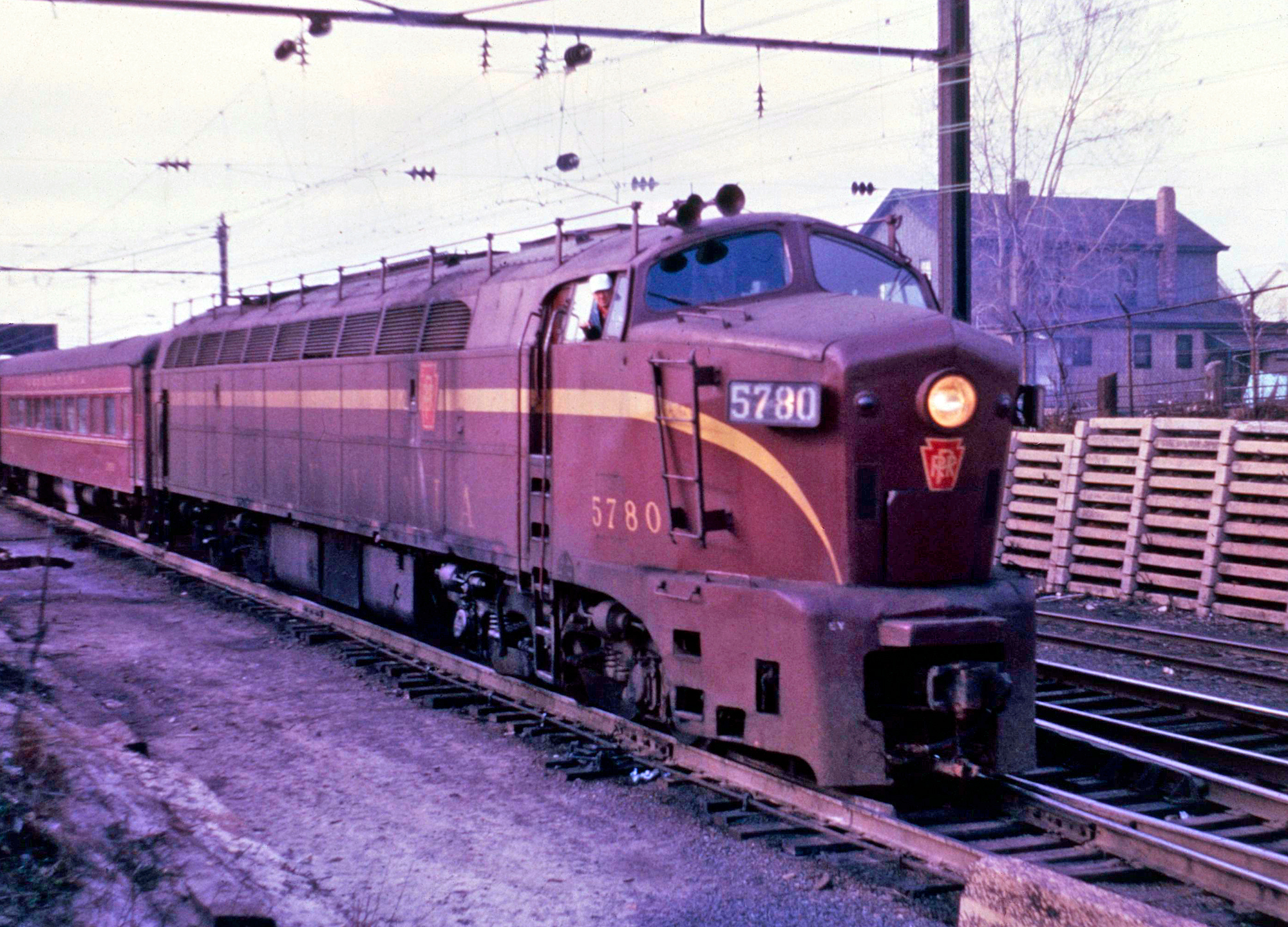 Pennsylvania DR-6-4-2000 #5780 works commuter service on the New York & Long Branch at South Amboy, New Jersey in April, 1964. Author's collection.
Pennsylvania DR-6-4-2000 #5780 works commuter service on the New York & Long Branch at South Amboy, New Jersey in April, 1964. Author's collection.Given the fact that by the late 1940s EMD simply had the market cornered on passenger models, and diesel locomotives in general, most of the railroads that ultimately purchased the DR-6-4-2000 variants did not use them long in revenue service.
The locomotives just were not as reliable and easy to maintain as EMDs and most were traded in or sold by the 1960s.
